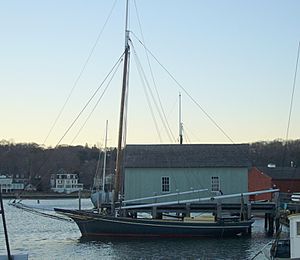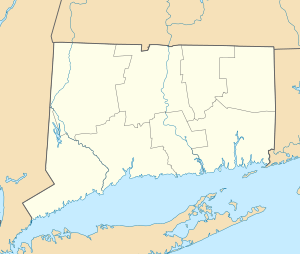Emma C. Berry (sloop) facts for kids
 |
|
| History | |
|---|---|
| Builder | Palmer Shipyards |
| Launched | 1866 |
| Status | Museum ship |
| General characteristics | |
| Tonnage | 15 GRT |
| Length |
|
| Beam | 14.6 ft (4.5 m) |
| Depth of hold | 5.7 ft (1.7 m) |
| Sail plan | Noank smack |
|
Emma C. Berry (Sloop)
|
|
|
U.S. Historic district
Contributing property |
|
| Location | Greenmanville Avenue, Mystic, Connecticut |
| Built | 1866 |
| Architect | James A. Latham |
| Part of | Mystic Bridge Historic District (ID79002671) |
| NRHP reference No. | 94001649 |
| Significant dates | |
| Added to NRHP | October 12, 1994 |
| Designated NHL | October 12, 1994 |
| Designated CP | August 31, 1979 |
The Emma C. Berry is a special fishing boat called a sloop. You can find her at the Mystic Seaport Museum in Mystic, Connecticut, USA. She is one of the oldest working boats still around in America. She is also the very last American well smack left. A "well smack" is a type of boat that had a special tank (or "well") in the middle. This tank was filled with seawater. It kept the fish fresh and alive until the boat returned to shore. This kind of boat is also known as a sloop smack or a Noank smack. The Noank design was so good that other places in the United States copied it.
The Emma C. Berry was built in 1866. She was made at the Palmer Shipyards in Noank, Connecticut by James A. Latham. The boat was named after Captain John Henry Berry's daughter. In 1886, her sails were changed to a different style called a schooner. Later, in 1916, a gasoline engine was added. In 1931, she was carefully fixed up to look just like she did when she was first built. Because she is so important, she was named a National Historic Landmark in 1994.
Contents
Building the Emma C. Berry
The Emma C. Berry was built in 1865 by John Latham. This happened at the R. & J. Palmer Shipyard in Noank, Connecticut. She was made for John Henry Berry. The ship was named after his daughter, Emma C. Berry. She was built in a similar way to other Noank smacks of that time. The ship was ready in 1866. She had a sloop rig, which means she had one main mast and two front sails.
The Emma C. Berry's Journey Through Time
The Emma C. Berry had many owners over the years. She started as a fishing boat, catching fish and lobsters. Around 1924, her time as a fishing vessel ended. She was left on the mudflats in Beals, Maine.
In 1926, a man named Milton Beal bought her. He used her to carry goods along the coast. This meant she became a freighter.
A few years later, in 1931, F. Slade Dale bought the ship. He loved old boats and decided to fix her up. He wanted her to look like she did when she was new. After her restoration, she was registered in Philadelphia. Dale owned her until 1969. Then, he gave her to the Mystic Seaport Museum.
In the 1960s, Captain Dayton O. Newton met Dale. Captain Newton was a bandmaster and a ship captain. He offered to get student volunteers to work on the Berry. In 1965, Captain Newton and his volunteers sailed the ship. They went up the Hudson River to Troy, New York. They carried important historical papers. During this trip, a famous folk singer named Pete Seeger even came aboard. He played a concert to help raise money for his own boat, the Clearwater.
In 1992, the Emma C. Berry sailed again. She went from the Mystic Seaport to Fishers Island Sound. This was the first time in 106 years she sailed with her original sloop rig.
Changes Over the Years
The Emma C. Berry changed a lot during her long life. Her sails were changed, and parts of her were modified and repaired.
- In 1887, her original sloop rig was changed to a schooner rig. This meant she had a different way of setting her sails.
- Around 1916, a Knox gasoline engine was put in. This helped her move even when there was no wind.
- Later, she was changed to be a freighter. The special "well" for keeping fish alive was removed.
In 1963, some repairs were done to make her safe to sail again.
Bringing Her Back to Life: Restoration
When the Emma C. Berry arrived at the Mystic Seaport, she needed a lot of work. Her first restoration happened from 1969 to 1971. During this time, workers brought back her original sloop rig. They also fixed the wet well for fish. Many old and rotting wooden parts were replaced.
After more research and old photos were found, the museum started a second restoration. This time, they fixed the deck and other parts. They wanted to make sure she looked exactly like she did in 1866. They studied old books and pictures to get every detail right. For example, they decided to paint her hull black. This was based on how other similar boats were painted back then.
Not everyone agreed with restoring her to a sloop. Jack Wilbur, a boat builder, thought it made more sense to keep her as a schooner. He said she sailed as a schooner for much longer than she was a sloop.
Why the Emma C. Berry is Important
The Emma C. Berry is very special. The official document that made her a National Historic Landmark says she is "the last known surviving American smack." This means she is the only one of her kind left. She is important because she shows us what the Noank smacks were like. She also had a very long working life, which makes her a great example of these historic fishing boats.


